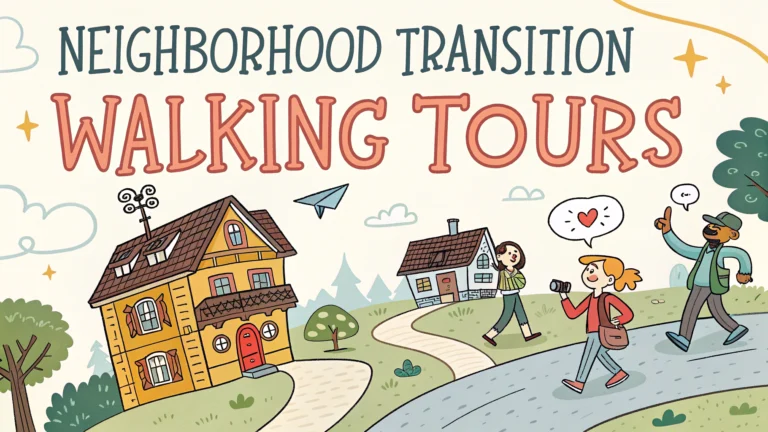Neighborhood transition walking tours offer a fascinating way to explore how communities evolve and change over time.
These self-guided walks reveal the layers of history, architecture, and social changes that shape our urban landscapes.
Planning Your Neighborhood Transition Tour
- Research historical maps and photos of your chosen area
- Download offline maps to your phone
- Wear comfortable walking shoes
- Bring a camera to document changes
- Pack water and snacks
What to Look For
Pay attention to these key elements during your walk:
- Architecture styles – Note how building designs change block by block
- Business types – Observe shifts in retail and commercial spaces
- Public spaces – Look for parks, plazas, and community gathering spots
- Street art – Murals and graffiti often tell stories of neighborhood change
- Infrastructure – Notice variations in sidewalks, lighting, and street furniture
Sample Route Structure
| Section | Focus Points |
|---|---|
| Starting Point | Historic district or landmark |
| Middle Section | Areas showing visible transformation |
| End Point | Newest development or future project site |
Documentation Tips
- Take photos from consistent angles to compare changes
- Record street names and intersections
- Note construction dates on buildings
- Screenshot Google Street View historical images for comparison
Safety Considerations
- Walk during daylight hours
- Share your route with someone
- Stay aware of your surroundings
- Respect private property
- Keep identification and emergency contacts handy
Helpful Resources
- Library of Congress Historical Maps
- National Archives – Historical photographs
- Local historical society websites
- Municipal planning department records
Connect with local architecture organizations or preservation societies for detailed information about specific buildings and neighborhoods.
Consider joining walking tour groups on social media platforms to share experiences and discover new routes.
Engaging with Local Community
Understanding neighborhood transitions involves connecting with the people who shape these spaces daily. Local perspectives provide invaluable context to physical changes.
- Visit neighborhood cafes and shops
- Attend community meetings
- Speak with long-time residents
- Research local community organizations
Documenting Social Changes
Demographics
- Population shifts
- Cultural influences
- Economic indicators
- Housing patterns
Community Initiatives
- Local improvement projects
- Grassroots movements
- Preservation efforts
- New developments
Creating Your Tour Report
Compile your findings into a comprehensive documentation of your neighborhood exploration:
- Write detailed observations
- Create before/after comparisons
- Map significant changes
- Include community perspectives
Conclusion
Neighborhood transition tours offer more than just physical observation – they provide insights into the dynamic nature of urban development and community evolution. By documenting these changes, we contribute to the historical record and better understand the forces shaping our cities.
Whether for personal interest or academic research, these walking tours help preserve the memory of changing neighborhoods while highlighting the importance of thoughtful urban development and community preservation.
FAQs
- What exactly is a neighborhood transition walking tour?
A neighborhood transition walking tour is a self-guided exploration that highlights how an area has changed over time, including architectural evolution, demographic shifts, and historical developments within specific neighborhoods. - How long does a typical self-guided neighborhood walking tour take?
Most self-guided neighborhood walking tours take between 1-2 hours to complete, covering approximately 1-3 miles, though visitors can adjust the pace to their preferences. - What should I bring on a neighborhood walking tour?
Essential items include comfortable walking shoes, weather-appropriate clothing, water, a smartphone or printed map, and a camera to document points of interest. - How can I access self-guided tour materials and maps?
Tour materials are typically available through local historical society websites, tourism offices, mobile apps, or downloadable PDF guides from neighborhood associations. - What’s the best time of day to take a neighborhood walking tour?
Daytime hours between 10 AM and 4 PM are optimal, offering good visibility and when most historical buildings or points of interest are accessible to view. - How do I identify historical landmarks during the tour?
Look for historical markers, plaques, distinctive architectural features, and reference your tour guide’s descriptions of significant buildings and locations. - Are neighborhood walking tours accessible for people with mobility issues?
Accessibility varies by neighborhood, but many tours include information about terrain, stairs, and alternative routes for those with mobility concerns. - What types of neighborhood changes should I look for during the tour?
Observe architectural styles from different eras, changes in building use, infrastructure developments, cultural landmarks, and signs of gentrification or preservation. - Is it safe to do self-guided walking tours alone?
While most neighborhood tours are designed with safety in mind, it’s recommended to research the area beforehand, stay aware of your surroundings, and consider touring during daylight hours. - How can I learn more about specific buildings or locations during the tour?
Use QR codes on historical markers, consult local archives, visit neighborhood historical societies, or use specialized walking tour apps that provide detailed historical information.








